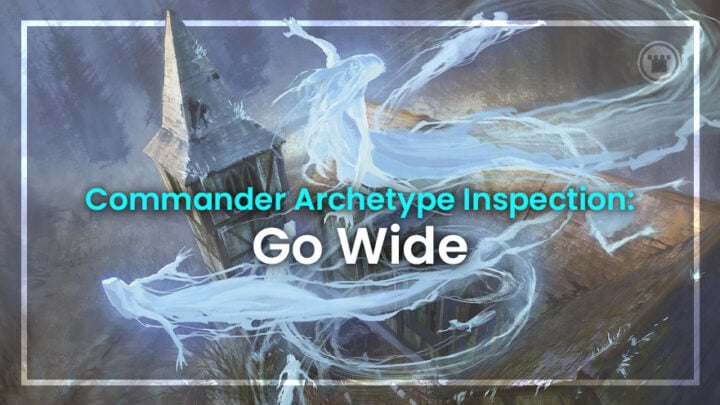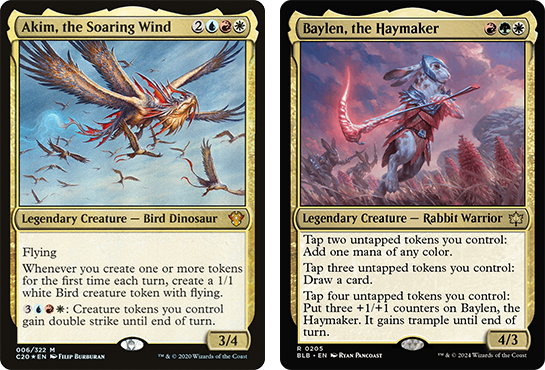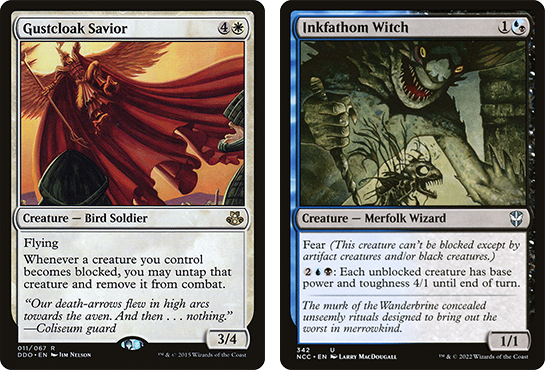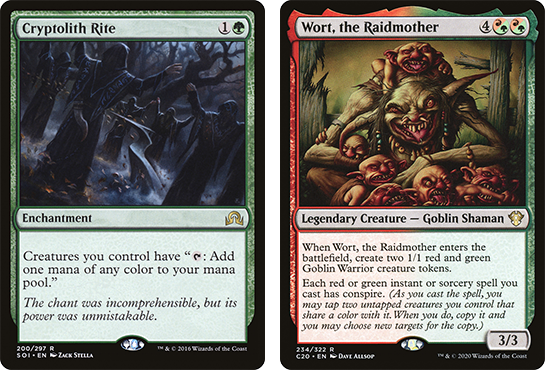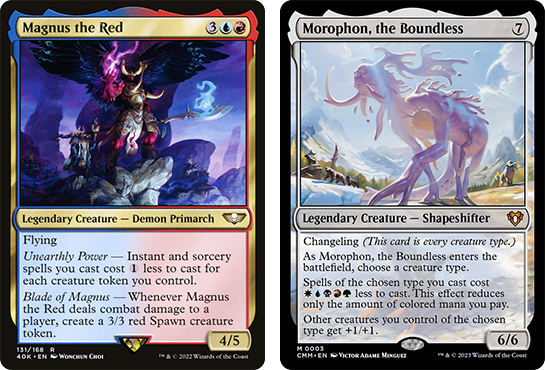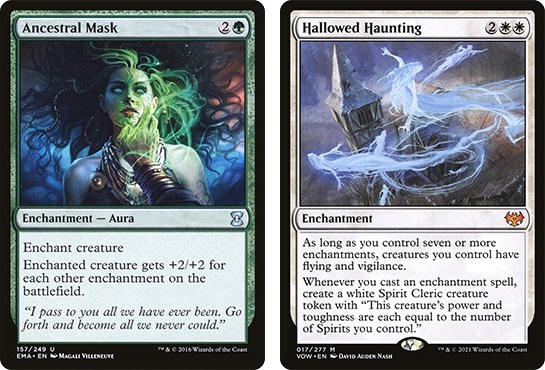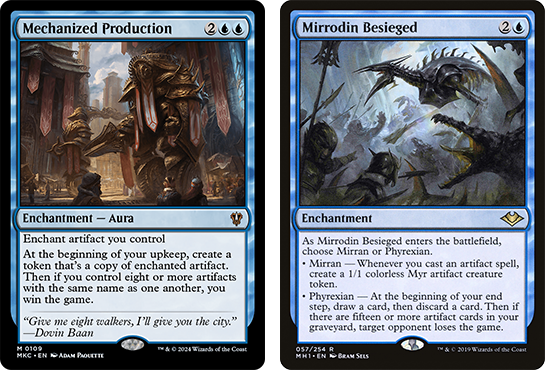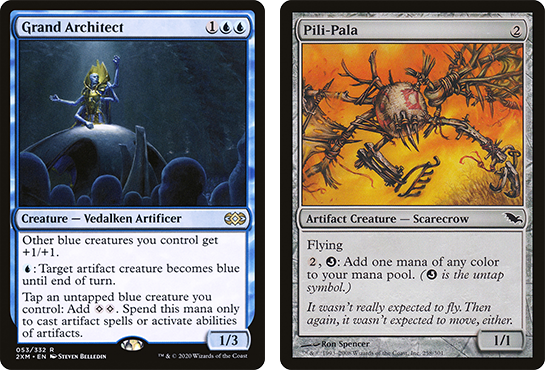Over the years, Magic has invented a multitude of mechanics to build decks around, each with its own unique advantages, dedicated support cards and memorable payoffs. But when all of those archetypes are thrown together into the grand melting pot of Commander, a few top-tier choices stand out. They offer versatile deck building options, consistent performance across different areas of the game and power ceilings which border on unbeatable.
This week, we’re looking at MY personal favorite archetype: Go Wide. That title is both a description and an instruction, as this strategy seeks to prove that quantity really does have a quality all its own.
THE NUMBERS GAME
Originating in 60-card Constructed, the term “going wide” describes attacking with a swarm of tiny creatures (as opposed to “going tall,” where you devote resources to making one or two attackers as big as possible). Going wide enough can effectively negate the impact of enemy removal and blockers, because the majority of your swarm will still get through.
It’s an inherently aggressive gameplan, both because you’re cashing in your resources to maximize short-term damage, and because flooding the board makes you incredibly vulnerable to sweepers and other late-game effects. That’s 60-card Magic though, and we all know that aggro decks in Commander require a very different approach. Trading our creatures for immediate damage won’t go far enough to bring down multiple 40-life opponents, especially with whoever we don’t kill first taking free shots at us while we’re tapped out.
Regardless of your archetype, winning in Commander generally means finding ways to scale the value of your board multiplicatively with each new turn, rather than linearly. Ramp spells give you the mana to cast even bigger ramp spells next turn. Every value-generating permanent you add to the board triggers all the ones you played before, and then increases the return you’ll get from the next one.
Go Wide decks achieve this by playing team-wide pump spells, or any other effect which affects “each creature you control.” You’re effectively multiplying the impact of the spell by the number of creatures you control, without paying any additional costs – and it’s not very hard to control a LOT of creatures if you’re really focused on it. The classic equation here is how many attackers you need before Rites of Initiation will be lethal damage. But once these spells start generating value beyond just damage, we can really get cooking.
This sort of value-per-creature spell is relatively rare to see on a one-shot spell, but it’s extremely easy to achieve the same thing with triggered abilities. Any ability which can trigger per-creature is a great deal for Go Wide decks: we have more creatures entering, dying, attacking, dealing damage and (sometimes) being sacrificed than anybody else! Just be very careful you have the right wording on some of these, because “Whenever a creature you control attacks” has a very different outcome to “whenever you attack”.
CROWD FUNDING
So even when we’re building our Go Wide decks very differently from their 60-card inspirations, the central question remains the same: “how fast can you widen your board?” Everything else, from economy to damage potential, is simply a function of that creature count.
We accelerate this growth by playing cheap spells that become multiple bodies, like offspring creatures from Bloomburrow or Resolute Reinforcements. Since it’s core to our gameplan, efficient token generation is also one of the most valuable abilities a Go Wide deck can put in the Command Zone. The pool of such commanders is deep, with great options in every color combination: consider Sai, Master Thopterist, Darien, King of Kjeldor, The Mycotyrant, Prossh, Skyraider of Kher, and Akim, the Soaring Wind.
But the really revolutionary thing is to have your permanents already in play help you pay to add more of them, leading to exponential or even infinite board-widening in a single turn! Almost every Go Wide commander deck will use its creatures as a resource this way, although the exact methods and mechanics may differ. Convoke (and other “tap an untapped creature you control” costs) are most common, but some decks can also harness affinity, improvise, sacrifice costs, conspire, and other creature-dependent discounts.
Making the most of some discounting mechanics requires you to be specific about the type of creatures you’re going wide with, which naturally elevates certain sub-genres within this archetype. For example, there are countless different creature typal decks in Commander which generate value by going wide. But Elves and Slivers have remained near the top of the pecking order for decades, thanks to their best-in-class ability to generate resources from their creature count.
If you’re not so lucky as to have engines like Gemhide Sliver or Heritage Druid in your card pool, then this is another effect that can be worth looking for from your Commander. Inga and Esika, Morophon, the Boundless, Tesak, Judith’s Hellhound, Magnus the Red, and Rakdos, Lord of Riots can all make a massive impact on how fast your army grows; either because their mana production is tied to creature count, or because they provide a flat per-spell discount which can potentially pay for many spells in a single turn.
Using your creatures for resource generation does potentially incur another cost, depending on the method: not having them available to attack or block. But like all the best Commander decks, it’s usually prudent to stay passive until your damage-multiplying equation is big enough to kill opponents in one swing. Instead of struggling to overcome Commander’s high life totals with early aggro, we can use that extra buffer to avoid chump-blocking and keep our creature count high.
I <3 GAME OBJECTS
The prevalence of creature tokens and typal decks has made Go Wide synonymous with creature strategies for most of Magic history. But the decade since the introduction of non-creature tokens has heralded much change, and it’s completely possible to replicate the deckbuilding and gameplay strategy of this archetype with noncreature permanents.
Even without the traditional focus on creatures and combat, artifact and enchantment themes tend to reward a “quantity over quantity” approach. Whether it’s maximizing the cost reduction from affinity, efficiently feeding your Arcbound Ravager or Auratog, drawing your deck with Enchantresses or making lethal with All That Glitters, the most important synergies all incentivize playing lots of cheap permanents.
Artifact decks specifically have gained the tools to take their Go Wide variation to another level. The generic mana cost of artifacts was always an obvious combination with cost-reduction mechanics, and there have been decks aiming to flood the board with artifacts since the 1990s. However, the addition of noncreature tokens has allowed them to go much wider, much faster. In effect, the minimum “cost” of a permanent has been reduced – and when all you care about is the number of permanents counting towards synergies like affinity or improvise, that’s a great thing.
The win conditions for these decks still come in a very wide variety. There are traditional combat damage payoffs like Cranial Plating, Kappa Cannoneer and Nettlecyst, and some powerful non-combat threats like Ghirapur Aether Grid or Mechanized Production. But as is common in Commander, resource-loop combos tend to be the most natural wincon to build around – you essentially win by adding pieces to your board until you hit that critical break point where you’re gaining value on spells.
Many of the classic artifact combos are built from cards you could credibly play on their own merits, making it plausible to assemble them “accidentally” through the normal Go Wide gameplan instead of needing to tutor for them. Any sustainable loop will be good enough, since even the smallest repeatable effect like Pyrite Spellbomb you can find on your board should be lethal. Examples include Sword of the Meek with Thopter Foundry, Krark-Clan Ironworks with recursion triggers like Myr Retriever and Scrap Trawler, Riddlesmith with Ovalchase Daredevil, or Grand Architect with Sai, Master Thopterist.
That’s not even considering the more straightforward A+B infinites you can sneak into this theme, like Grand Architect with Pili-Pala, Painter’s Servant with Grindstone, or Rings of Brighthearth with Basalt Monolith. Artifact-themed Go Wide decks also aren’t under any special restriction that would stop them swarming in for a combat victory with gnomes and thopters – Brudiclad players especially can attest to artifact token beatdown’s effectiveness. The versatility and efficiency of a well-built artifact deck ends up being more than enough to banish any lingering regrets about the loss of inherent combat potential from scaling back the creatures.
SEEING THE WIDER PICTURE
Go Wide decks are a natural fit for the pace and conditions of Commander, and with the right wincons and resource mechanics they can prove a match for even high-powered tables.
The sheer variety of themes you can layer on top of this fundamental deckbuilding and strategy concept means you won’t have to grapple with a single prevalent build or win condition. Leaving room for personalization and customization in your archetype is very important to the spirit of Commander as a format, and it’s why I’ll never get bored of adding yet more Go Wide decks to my collection.
Even just the fact that this is one of the few Commander archetypes which makes attacking and blocking really matter again is awesome, given that creature combat is among the most interesting and skill-testing parts of Magic gameplay! Yes, you might be a little vulnerable to sweepers – but there’s more ways to play around those with each passing set, from Akroma’s Will to Dawn’s Truce. Or you can tweak your build to care about noncreature permanents like Auras or Food instead, giving you a more resilient on-board store of value.
Regardless of what permanent type you end up focusing your synergies toward, you can be comforted that the most important thing to remember is also the easiest. Go Wide.

Tom’s fate was sealed in 7th grade when his friend lent him a pile of commons to play Magic. He quickly picked up Boros and Orzhov decks in Ravnica block and has remained a staunch white magician ever since. A fan of all Constructed formats, he enjoys studying the history of the tournament meta. He specializes in midrange decks, especially Death & Taxes and Martyr Proc. One day, he swears he will win an MCQ with Evershrike. Ask him how at @AWanderingBard, or watch him stream Magic at twitch.tv/TheWanderingBard.

